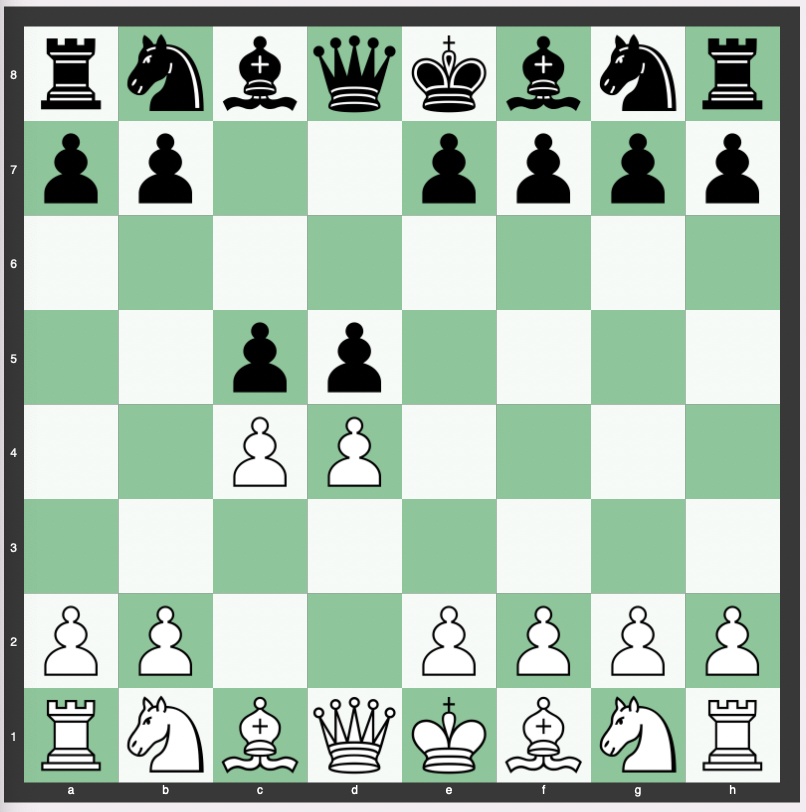The game of chess has fascinated and challenged minds for centuries, and one of the engaging aspects is the study of various openings.
One such opening is the Symmetrical Defense against the Queen’s Gambit, beginning with the moves 1.d4 d5 2.c4 c5.
Here we explore this opening, looking into its theory, variations, history, suitability for different skill levels, and prevalence in grandmaster play.
Move Order of the Symmetrical Defense
The Symmetrical Defense is initiated with the following moves:
- White plays 1.d4, controlling the center.
- Black responds with 1…d5, mirroring White’s play and contesting the center.
- White continues with 2.c4, attacking Black’s central pawn.
- Black answers with 2…c5, a symmetrical response that challenges White’s setup.

Theory, Strategy, and Purpose of the Symmetrical Defense
The Symmetrical Defense is an aggressive response to the Queen’s Gambit that aims to counterbalance White’s central control.
The 2…c5 move immediately challenges White’s central pawn and seeks to disrupt the traditional plans associated with the Queen’s Gambit.
By choosing a symmetrical setup, Black tries to nullify White’s opening advantage and strives for an equal or even advantageous position.
The opening requires an understanding of pawn structures and subtle positional nuances, making it rich in strategic complexity.
Variations of the Symmetrical Defense
Several variations can arise from the Symmetrical Defense, depending on how both players continue:
- If White captures on d5 (the most theoretically proper), Black may recapture with the queen, leading to different pawn structures.
- If White defends the d4 pawn with e3 or Nf3, various tactical battles and maneuvering play may arise.
- Various other move orders can lead to different lines, making this a highly flexible and complex opening.
Evaluation of the Symmetrical Defense
The evaluation of the Symmetrical Defense is +0.65 to +0.90.
Sample Continuation Lines of the Symmetrical Defense
Continuation lines of the Symmetrical Defense include:
3. cxd5 Qxd5 4. Nf3 cxd4 5. Nc3 Qa5 6. Nxd4 Nf6 7. Nb3 Qc7 8. e4 Nc6 9. Be3 e6 10. Rc1 Bd6 11. g3 Bb4 12. Bg2
3. cxd5 Qxd5 4. Nf3 cxd4 5. Nc3 Qa5 6. Nxd4 Nf6 7. Nb3 Qh5 8. e4 Qxd1+ 9. Kxd1 e5 10. Bb5+ Nbd7 11. f3 a6 12. Be2 Nc5 13. Na5 Be6 14. Be3 Rc8 15. Rc1 Be7 16. b4 Ncd7
3. cxd5 Qxd5 4. Nf3 cxd4 5. Nc3 Qa5 6. Nxd4 Nf6 7. Nb3 Qh5 8. Bd2 e5 9. e3 Qxd1+ 10. Rxd1 a6 11. Bc4 Nbd7 12. O-O Nb6 13. Na5 Rb8 14. f3 g6 15. Kh1 Bb4 16. Ne4 Bxd2
3. cxd5 Qxd5 4. Nf3 cxd4 5. Nc3 Qa5 6. Nxd4 Nf6 7. Nb3 Qh5 8. g3 e6 9. Bg2 Bb4 10. O-O O-O 11. e4 Qxd1 12. Rxd1 Nc6 13. Nb5 e5 14. Be3 Be6 15. Nc5 Bxc5 16. Bxc5 Rfc8 17. f3
3. cxd5 Nf6 4. e4 Nxe4 5. dxc5 Qa5+ 6. Bd2 Nxd2 7. Qxd2 Qxd2+ 8. Nxd2 g6 9. Rc1 Bh6 10. Bb5+ Nd7 11. c6 bxc6 12. dxc6 Nb6 13. Ngf3 O-O 14. O-O a6 15. Be2 Bg4 16. Rc2 Bf5 17. Rc5 Na4 18. Re5 Nxb2 19. Rxe7 Rfc8 20. Nc4 Bf8 21. Rb7
3. cxd5 Qxd5 4. Nf3 cxd4 5. Nc3 Qa5 6. Nxd4 Nf6 7. Nb3 Qc7 8. Nb5 Qe5 9. e4 e6 10. Qd4 Qxd4 11. N3xd4 Kd8 12. Nc3 e5 13. Nc2 Be6 14. Bg5 Be7 15. O-O-O+ Ke8 16. f3 Nc6 17. Be3 Rd8 18. Bb5 Rxd1+ 19. Rxd1
History of the Symmetrical Defense
The Symmetrical Defense has been known and played since the 19th century. Its popularity has waxed and waned over time, with periods of interest followed by times of neglect.
Many famous players, including grandmasters, have employed this opening, contributing to its rich history and ongoing development.
Is the Symmetrical Defense Good for Beginners or Intermediates?
The Symmetrical Defense can be suitable for both beginners and intermediate players.
For beginners, it offers a straightforward plan and logical development of pieces.
For intermediate players, the rich strategic complexity and potential for counterplay offer opportunities to deepen understanding and improve skills.
However, some lines may require careful study, making it more suited to players willing to invest time in learning its nuances.
How Often Is the Symmetrical Defense Played at the Grandmaster Level?
While not as popular as some other responses to the Queen’s Gambit, the Symmetrical Defense has seen play at the grandmaster level.
Its usage has varied over time, with some grandmasters employing it as a surprise weapon or when seeking active counterplay.
Statistically, it remains a less common choice, but it continues to have a presence in high-level play.
Conclusion
The Symmetrical Defense against the Queen’s Gambit, initiated by the moves 1.d4 d5 2.c4 c5, is an intriguing and multifaceted opening.
It offers a blend of strategic complexity and tactical possibilities, appealing to players of various skill levels.
Though not as prevalent at the grandmaster level as other openings, its rich history, adaptable nature, and unique character continue to make it an interesting and viable choice for many chess enthusiasts.
Whether you are a beginner looking for an engaging response to 1.d4 or an intermediate player seeking to deepen your understanding of complex positions, the Symmetrical Defense might be an opening worth exploring.


